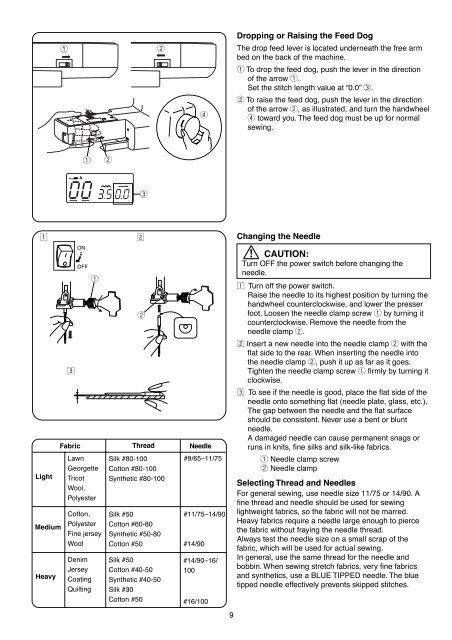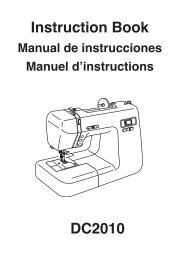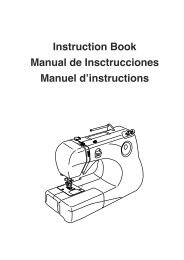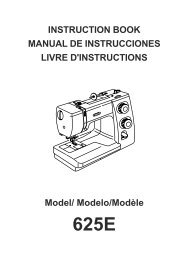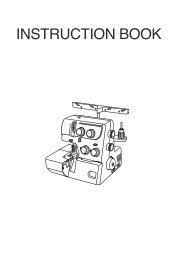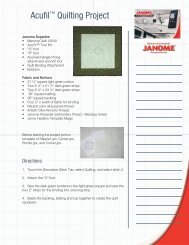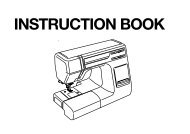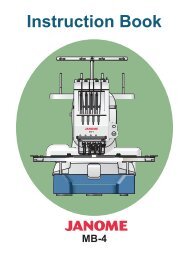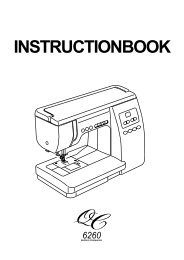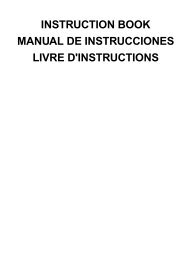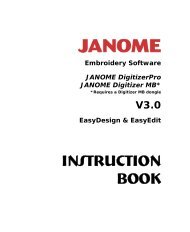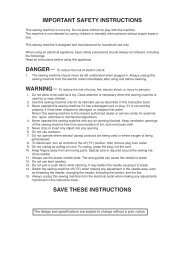INSTRUCTION BOOK - Janome
INSTRUCTION BOOK - Janome
INSTRUCTION BOOK - Janome
Create successful ePaper yourself
Turn your PDF publications into a flip-book with our unique Google optimized e-Paper software.
z x<br />
Light<br />
Medium<br />
Heavy<br />
q w<br />
c<br />
Fabric<br />
q<br />
Lawn<br />
Georgette<br />
Tricot<br />
Wool,<br />
Polyester<br />
Cotton,<br />
Polyester<br />
Fine jersey<br />
Wool<br />
Denim<br />
Jersey<br />
Coating<br />
Quilting<br />
q<br />
w<br />
e<br />
w<br />
Thread Needle<br />
Silk #80-100<br />
Cotton #80-100<br />
Synthetic #80-100<br />
Silk #50<br />
Cotton #60-80<br />
Synthetic #50-80<br />
Cotton #50<br />
Silk #50<br />
Cotton #40-50<br />
Synthetic #40-50<br />
Silk #30<br />
Cotton #50<br />
r<br />
#9/65–11/75<br />
#11/75–14/90<br />
#14/90<br />
#14/90–16/<br />
100<br />
#16/100<br />
9<br />
Dropping or Raising the Feed Dog<br />
The drop feed lever is located underneath the free arm<br />
bed on the back of the machine.<br />
q To drop the feed dog, push the lever in the direction<br />
of the arrow q.<br />
Set the stitch length value at “0.0” e.<br />
w To raise the feed dog, push the lever in the direction<br />
of the arrow w, as illustrated, and turn the handwheel<br />
r toward you. The feed dog must be up for normal<br />
sewing.<br />
Changing the Needle<br />
CAUTION:<br />
Turn OFF the power switch before changing the<br />
needle.<br />
z Turn off the power switch.<br />
Raise the needle to its highest position by turning the<br />
handwheel counterclockwise, and lower the presser<br />
foot. Loosen the needle clamp screw q by turning it<br />
counterclockwise. Remove the needle from the<br />
needle clamp w.<br />
x Insert a new needle into the needle clamp w with the<br />
flat side to the rear. When inserting the needle into<br />
the needle clamp w, push it up as far as it goes.<br />
Tighten the needle clamp screw q firmly by turning it<br />
clockwise.<br />
c To see if the needle is good, place the flat side of the<br />
needle onto something flat (needle plate, glass, etc.).<br />
The gap between the needle and the flat surface<br />
should be consistent. Never use a bent or blunt<br />
needle.<br />
A damaged needle can cause permanent snags or<br />
runs in knits, fine silks and silk-like fabrics.<br />
q Needle clamp screw<br />
w Needle clamp<br />
Selecting Thread and Needles<br />
For general sewing, use needle size 11/75 or 14/90. A<br />
fine thread and needle should be used for sewing<br />
lightweight fabrics, so the fabric will not be marred.<br />
Heavy fabrics require a needle large enough to pierce<br />
the fabric without fraying the needle thread.<br />
Always test the needle size on a small scrap of the<br />
fabric, which will be used for actual sewing.<br />
In general, use the same thread for the needle and<br />
bobbin. When sewing stretch fabrics, very fine fabrics<br />
and synthetics, use a BLUE TIPPED needle. The blue<br />
tipped needle effectively prevents skipped stitches.


